Are you tired of power outages disrupting your daily activities? A pure sine wave inverter might be the solution you've been looking for. In this article, we will explore everything you need to know about pure sine wave inverters and how they can improve your electrical experience.
Table of Content
What is Pure Sine Wave Inverter
A pure sine wave inverter is an electronic device that converts direct current (DC) power from a battery or other power sources into alternating current (AC) power with a clean and smooth sine wave. Unlike modified sine wave inverters that produce a stepped waveform, pure sine wave inverters generate an AC output that closely resembles the electricity provided by utility companies.
This type of inverter is designed to replicate the quality of power found in electrical grids, making it ideal for powering sensitive electronics such as laptops, smartphones, medical equipment, and household appliances. The clean and smooth sine wave produced by pure sine wave inverters ensures greater compatibility, improved performance, and enhanced efficiency for these devices.

Pure sine wave inverters offer several advantages over modified sine wave inverters. They provide a consistent and stable power supply, allowing appliances to operate at their full capacity without any issues. They also reduce electrical noise and interference, which can improve the performance and lifespan of electronic devices. Additionally, pure sine wave inverters are more energy-efficient, resulting in longer battery life and reduced power consumption.
How Does the Pure Sine Wave Inverter Work?
A pure sine wave inverter works by converting DC (direct current) power from a battery or other DC source into AC (alternating current) power with a clean and smooth sine wave. The conversion process involves several steps:
- Rectification:The input DC power is first converted into a stable DC voltage by rectifying it. This is typically done using diodes to convert the AC power from the battery into a pulsating DC power.
- Filtering: The pulsating DC power is then passed through a filter to smooth out the waveform and remove any remaining AC ripple. This is achieved using capacitors and inductors that help to eliminate the high-frequency components of the waveform.
- Inversion: The filtered DC power is then fed into an inverter circuit, which converts it into AC power. The inverter circuit consists of power transistors or insulated-gate bipolar transistors (IGBTs) that switch on and off at high frequencies to create the AC waveform.
- Pulse Width Modulation (PWM): To generate a smooth sine wave, the inverter uses a technique called Pulse Width Modulation (PWM). PWM involves varying the width of the pulses from the inverter circuit to mimic the shape of a sine wave.
- Output Filtering: The output waveform is further filtered to remove any harmonic distortion and noise. This is achieved using additional filters consisting of capacitors, inductors, and transformers, which help to smooth out the waveform.
The end result is a pure sine wave output that closely matches the quality and characteristics of the AC power supplied by utility companies. This clean and stable power is suitable for powering sensitive electronics and appliances without causing any damage or performance issues.
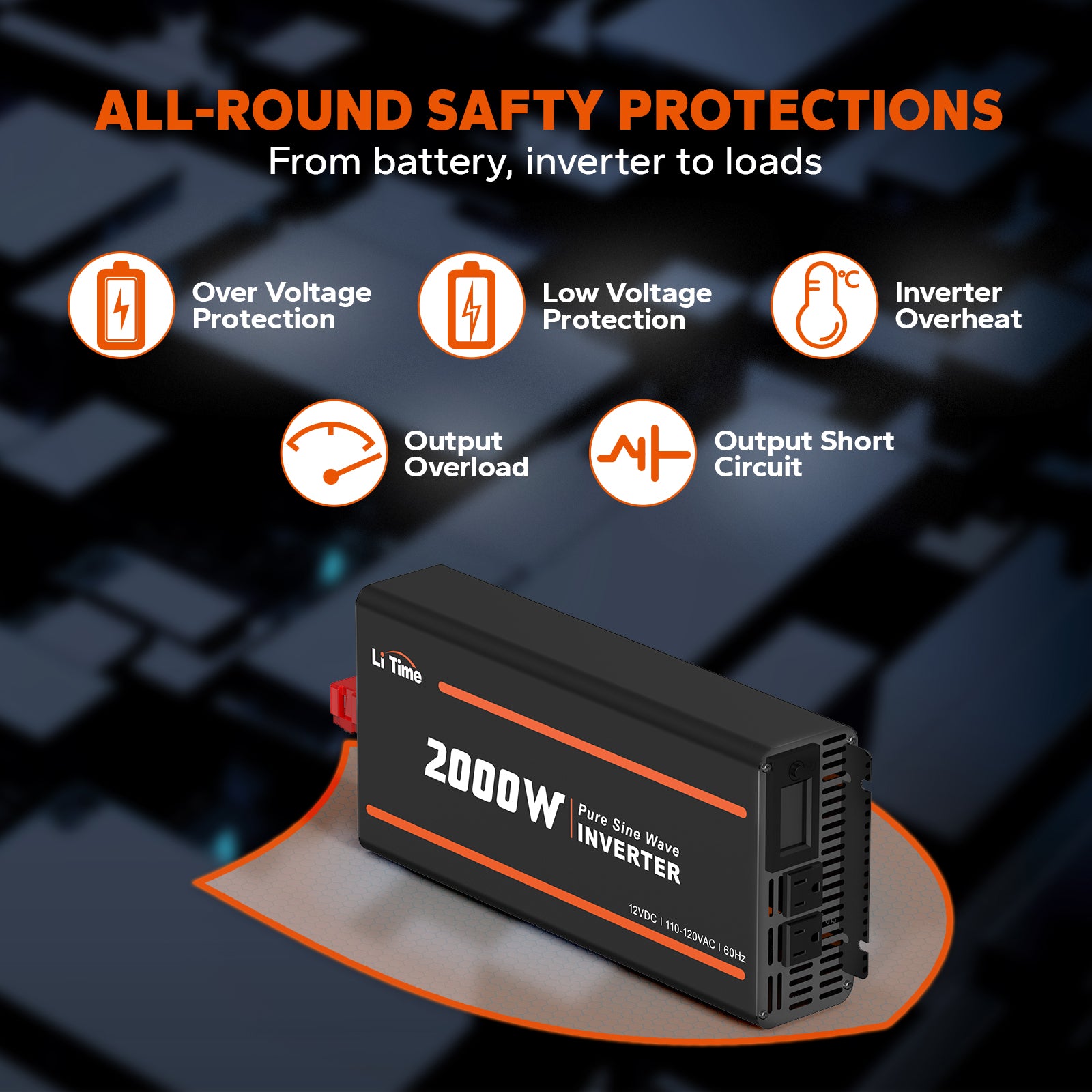
What are the Differences Between Modified Sine Wave Inverter and Pure Sine Wave Inverter
Modified sine wave inverters and pure sine wave inverters are two types of inverters used to convert DC power into AC power. The main difference between them lies in the output waveform they produce.
Output waveform: A modified sine wave inverter produces an output waveform that is a modified or stepped approximation of a true sine wave. It consists of a series of stepped voltage levels, resulting in a waveform that is blocky or square in shape. On the other hand, a pure sine wave inverter produces a smooth and clean sine wave output that replicates the waveform of utility power.
Compatibility: Pure sine wave inverters are designed to be compatible with a wide range of electronic devices and appliances. They are suitable for powering sensitive equipment, including medical devices, audio equipment, computers, and refrigeration systems. Modified sine wave inverters may not be compatible with certain devices. Some appliances, such as variable speed motors, may not run properly or may be damaged when powered by a modified sine wave inverter.
Performance: Pure sine wave inverters provide a superior quality of power, enabling devices to operate at their full capacity. They can handle reactive loads and startup surge currents, making them more efficient and reliable. Modified sine wave inverters, due to their waveform characteristics, may not provide optimal performance for certain devices. Appliances powered by modified sine wave inverters may produce buzzing or humming sounds, run hotter, consume more power, and may not operate as efficiently as they would with pure sine wave power.
Electrical noise and interference: Pure sine wave inverters produce a clean and stable waveform, minimizing electrical noise and interference. This helps in protecting sensitive electronics, reduces the risk of malfunctions, and extends the lifespan of equipment. Modified sine wave inverters, due to their waveform characteristics, may introduce electrical noise and electromagnetic interference (EMI) into the power supply, which can affect the performance of audio and video equipment and cause interference in sensitive electronics.
Price: Modified sine wave inverters are generally less expensive compared to pure sine wave inverters. However, the price difference has been decreasing over the years, making pure sine wave inverters more affordable and accessible.
Benefits of Pure Sine Wave Inverter over Modified Since Wave Inverter
Pure sine wave inverters offer several advantages over other types of inverters, such as:
Compatibility: Pure sine wave inverters can power sensitive devices with electronic components that require a clean and stable power supply. They are compatible with a wide range of devices, including laptops, appliances, medical equipment, and more.
Optimal Performance: Devices powered by pure sine wave inverters operate more efficiently and perform better. This is particularly important for motors, audio equipment, and other devices that require a smooth and consistent power supply
Reduced Electrical Noise: Pure sine wave inverters produce less electrical noise and interference compared to modified sine wave inverters. This helps avoid potential problems like buzzing sounds in audio equipment or disruptions in sensitive electronic devices.
Reliably powers devices that typically cannot work with modified sine wave inverters:
- Laser printers, copiers, magneto-optical drives
- Some laptops (consult your manufacturer)
- Some fluorescent lights with electronic ballasts
- Power tools with "solid-state" power or variable speed control
- Some wireless tool battery chargers
- Some newer furnaces and pellet stoves with microprocessor control
- Digital clocks with radios
- Sewing machines with speed/microprocessor control
- X-10 home automation systems
- Oxygen concentrators and other medical equipment
What Size Inverter Do I Need?
Properly sizing your power output is critical. Inverters are rated by wattage, indicating how many watts they can run at once. For instance, if you have a 500 Watt fridge and an 800 Watt air conditioning unit, you would need an inverter with a wattage higher than 1300W. LiTime's 2000W inverters are ideal for meeting your power requirements.

Check the voltage of your battery. The DC voltage rating on the inverter will indicate which battery bank it is compatible with. For instance, a 12V battery bank will require an inverter that is compatible with a 12V DC input.
Additionally, it is important to consider the efficiency of the inverter. Inverters have an efficiency rating that indicates how well they convert DC power from the battery to AC power. A higher efficiency rating means less power loss during the conversion process. Choosing a higher efficiency inverter can help save energy and ensure maximum power output.
Another factor to consider is the inverter's peak power capability. Some devices, especially those with motors or compressors, require a high amount of power during startup or when experiencing a surge. The inverter should be able to handle these peak power demands to avoid overloading or damaging the equipment.
It is also recommended to leave some headroom when selecting an inverter. Choosing a slightly larger inverter than the calculated total power consumption can provide flexibility for future needs or unexpected power surges.
If you are unsure about the appropriate size of the inverter for your specific requirements, it is always best to consult the manufacturer or seek advice from an expert in the field. They can provide guidance based on your power needs and help you select an inverter that meets your requirements.
Steps on How To Connect Pure Sine Wave Inverter to Your Battery
Take LiTime 2000W Pure Sine Wave inverter for example.
Avoid direct contact between the terminals of positive and negative wires connected to the battery, and do not reverse the positive and negative connections.
Step 1: Connect the included wires to the battery terminals.

Step 2: Make sure the intverter is in the OFF status. Considering the safety, this step is really important.
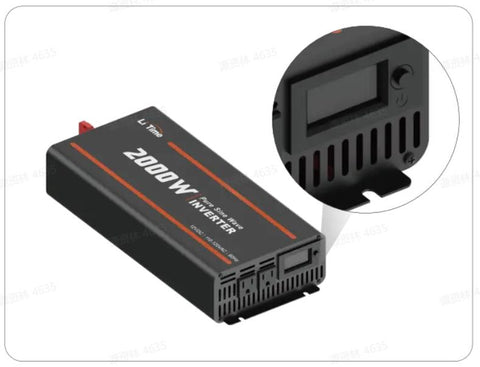
Step 3: Remove the insulating caps on the terminals, and unscrew the metal hexagon nuts with flange from the bolts.
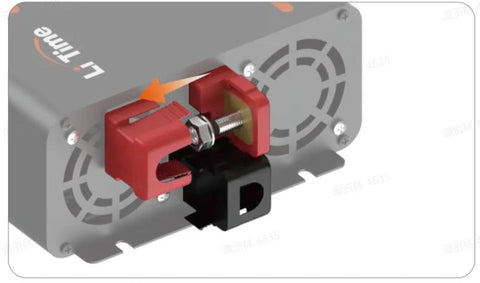
Step 4: Attach the wire lugs and metal hexagon nuts with flange to the bolts in the following sequence: Wire Lug → Metal Hexagon Nut with Flange.
Use a torque wrench to tighten the nuts to the bolts under the 12N·m to 14N·m setting to connect the wires to the inverter, positive to positive; negative to negative.
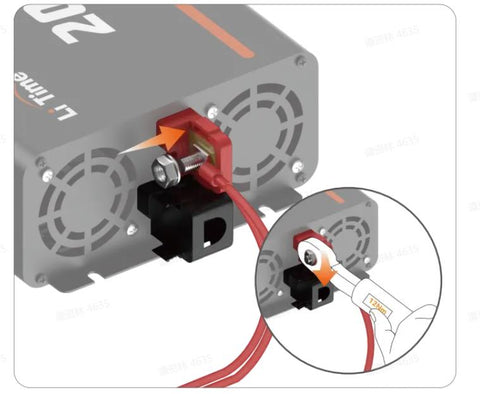
Step 5: Put on the insulating caps.
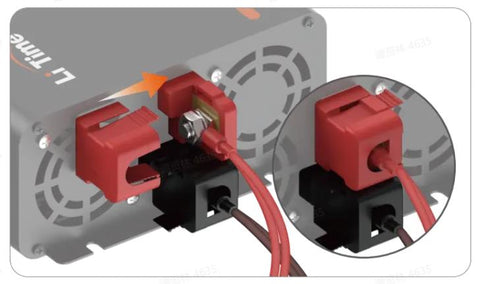
Step 6: Turn ON the inverter power, the monitoring screen will light up assuming proper battery connection, and the inverter is now ready for use.

Connecting to Devices
Make sure the inverter is in the OFF position before connecting loads (electronic devices) to the AC outlets.
Avoid switching on the inverter with the load already turned on. This may trigger an overload since some electronic devices have an initial high power surege to start.
Be sure to turn off all loads first before switching off the inverter. Even if the inverter is turned off, the capcacitors will still have a charge, so the DC and AC terminals must be disconnected if altering the circuitry.
FAQs about Inverter
1. Are there any devices that may not be compatible with a pure sine wave inverter?
In general, pure sine wave inverters are compatible with most devices. However, some devices may not work as expected or perform optimally when powered by a pure sine wave inverter. Certain less common devices or older models that were designed to work specifically with modified sine wave inverters may encounter compatibility issues. It's always a good idea to check the compatibility of the devices you plan to power with the manufacturer or consult the device's documentation.
2. Does a Fridge Need Pure Sine Wave?
Yes, a fridge can benefit from a pure sine wave inverter. Refrigerators typically have sensitive electronics, such as compressors and control circuits, which are designed to work with a clean and stable power supply. Pure sine wave inverters provide a smooth and consistent waveform, similar to grid power, ensuring proper operation and preventing any potential damage to the fridge's electronics.
Using a modified sine wave inverter with a fridge may cause issues such as increased energy consumption, noise, and inefficient operation. Additionally, some fridges may not even work with a modified sine wave inverter. Hence, it is generally recommended to use a pure sine wave inverter to power a fridge.
3. Can Inverter Damage Electronics?
Inverters can potentially damage electronics if they do not provide a clean and stable power supply. Modified sine wave inverters, in particular, have the potential to harm sensitive electronics due to the waveform they produce, which is not as smooth and consistent as the power provided by the grid or a pure sine wave inverter.
The voltage spikes, harmonic distortion, and electrical noise generated by modified sine wave inverters can lead to issues such as increased heat, reduced efficiency, malfunctions, or even permanent damage to electronic devices. In contrast, pure sine wave inverters provide a clean and stable power supply, similar to grid power, ensuring compatibility and safe operation of sensitive electronics.
It's important to choose the appropriate type of inverter for the specific electronics you wish to power to avoid any potential damage or performance issues. Reading the manufacturer's specifications or consulting with an expert can help ensure compatibility and protect your electronics.
Final Thoughts
Inverter is a crucial part of your solar system, choosing the inverters from trustworthy brand like LiTime can help to ensure a high-quality and reliable product. It is also recommended to consult the manufacturer's guidelines or seek expert advice when selecting an inverter, especially for complex systems or sensitive devices.
Remember, investing in a high-quality inverter is a long-term investment in the performance and longevity of your solar power system. So take the time to research and select the best inverter that meets your specific requirements, and enjoy the clean and reliable power it provides for years to come.








